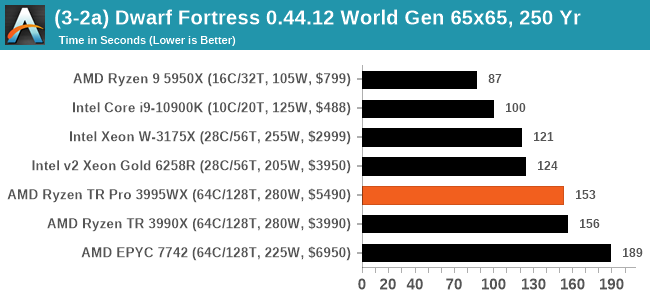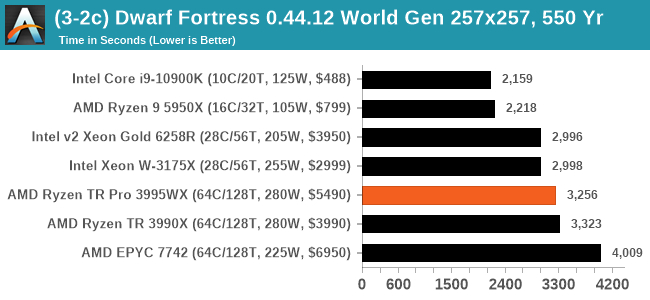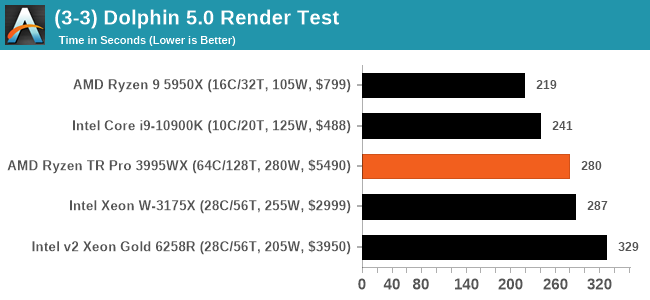64 Cores of Rendering Madness: The AMD Threadripper Pro 3995WX Review
by Dr. Ian Cutress on February 9, 2021 9:00 AM EST- Posted in
- CPUs
- AMD
- Lenovo
- ThinkStation
- Threadripper Pro
- WRX80
- 3995WX
CPU Tests: Simulation
Simulation and Science have a lot of overlap in the benchmarking world, however for this distinction we’re separating into two segments mostly based on the utility of the resulting data. The benchmarks that fall under Science have a distinct use for the data they output – in our Simulation section, these act more like synthetics but at some level are still trying to simulate a given environment.
DigiCortex v1.35: link
DigiCortex is a pet project for the visualization of neuron and synapse activity in the brain. The software comes with a variety of benchmark modes, and we take the small benchmark which runs a 32k neuron/1.8B synapse simulation, similar to a small slug.
The results on the output are given as a fraction of whether the system can simulate in real-time, so anything above a value of one is suitable for real-time work. The benchmark offers a 'no firing synapse' mode, which in essence detects DRAM and bus speed, however we take the firing mode which adds CPU work with every firing.
The software originally shipped with a benchmark that recorded the first few cycles and output a result. So while fast multi-threaded processors this made the benchmark last less than a few seconds, slow dual-core processors could be running for almost an hour. There is also the issue of DigiCortex starting with a base neuron/synapse map in ‘off mode’, giving a high result in the first few cycles as none of the nodes are currently active. We found that the performance settles down into a steady state after a while (when the model is actively in use), so we asked the author to allow for a ‘warm-up’ phase and for the benchmark to be the average over a second sample time.
For our test, we give the benchmark 20000 cycles to warm up and then take the data over the next 10000 cycles seconds for the test – on a modern processor this takes 30 seconds and 150 seconds respectively. This is then repeated a minimum of 10 times, with the first three results rejected. Results are shown as a multiple of real-time calculation.

This test prefers monolithic silicon with proportionally lots of memory bandwidth, which means that we get somewhat of an equalling of results here. The top result in our benchmark database is actually single chiplet Ryzen.
Dwarf Fortress 0.44.12: Link
Another long standing request for our benchmark suite has been Dwarf Fortress, a popular management/roguelike indie video game, first launched in 2006 and still being regularly updated today, aiming for a Steam launch sometime in the future.
Emulating the ASCII interfaces of old, this title is a rather complex beast, which can generate environments subject to millennia of rule, famous faces, peasants, and key historical figures and events. The further you get into the game, depending on the size of the world, the slower it becomes as it has to simulate more famous people, more world events, and the natural way that humanoid creatures take over an environment. Like some kind of virus.
For our test we’re using DFMark. DFMark is a benchmark built by vorsgren on the Bay12Forums that gives two different modes built on DFHack: world generation and embark. These tests can be configured, but range anywhere from 3 minutes to several hours. After analyzing the test, we ended up going for three different world generation sizes:
- Small, a 65x65 world with 250 years, 10 civilizations and 4 megabeasts
- Medium, a 127x127 world with 550 years, 10 civilizations and 4 megabeasts
- Large, a 257x257 world with 550 years, 40 civilizations and 10 megabeasts
DFMark outputs the time to run any given test, so this is what we use for the output. We loop the small test for as many times possible in 10 minutes, the medium test for as many times in 30 minutes, and the large test for as many times in an hour.



Dwarf Fortress is mainly single-thread limiting, hence the 64-core models at the back end of the queue. The TR parts are still a good bit faster than the EPYC.
Dolphin v5.0 Emulation: Link
Many emulators are often bound by single thread CPU performance, and general reports tended to suggest that Haswell provided a significant boost to emulator performance. This benchmark runs a Wii program that ray traces a complex 3D scene inside the Dolphin Wii emulator. Performance on this benchmark is a good proxy of the speed of Dolphin CPU emulation, which is an intensive single core task using most aspects of a CPU. Results are given in seconds, where the Wii itself scores 1051 seconds.

Similarly here, single thread performance matters.












118 Comments
View All Comments
kwinz - Wednesday, February 10, 2021 - link
Really? CPUs are in high demand because GPU programming is hard? That's what you're going with?Gomez Addams - Wednesday, February 10, 2021 - link
Good heavens that was painful to read. Some of the worst writing have had to suffer through in a while. One tip : compute is a verb and not a noun, just as simulation is a noun and simulate is a verb. Just because marketing droids use a term does not mean it is correct.Spunjji - Thursday, February 11, 2021 - link
Sorry pal, language doesn't work that way. You may not *like* it, but that's the way it is!croc - Wednesday, February 10, 2021 - link
Are we now ignoring the elephant? EPYC was to launch in 2020. Actually, AMD said that Zen 3 would launch in 2020, but there's a weasel in them words... SOME of the Zen 3 cpu's DID launch, mostly looking like paper though. EPYC is sort-of launching as we speak, and Zen 3 Threadripper is a no-show.I have said this elsewhere, and I will say it here. It would appear that AMD's lack of fab experience is showing, as they seem to be having issues getting their designs to fab properly at 7nm. Low to no yields? And TSMC is having issues of their own with China buying up as much talent as it can, while threatening to just grab it all in a military takeover. TSMC should have already built an advanced fab somewhere in the west, out of China's reach. Europe? Canada? After Trump, I would say to avoid the US as much as it needs to avoid China.
Spunjji - Thursday, February 11, 2021 - link
AMD were hoping to get Milan into production in Q3 2020 and have it shipping to some customers by Q4, which they did. It's not available to OEMs yet, so hardly a fanfare moment, but not the "elephant" you're trying to paint it as either.Same goes for Zen 3, too - it absolutely wasn't a "paper launch" - but I see you're just here to push FUD rather than discuss *the article*.
Like, what's this "they seem to be having issues getting their designs to fab properly at 7nm" crap? Whose backside are you pulling that out of?
Amazing how many people seem to think these comment sections are the ideal place to grind their own personal political axes.
Oxford Guy - Thursday, February 11, 2021 - link
‘Amazing how many people seem to think these comment sections are the ideal place to grind their own personal political axes’You seem to think this is your personal website.
Qasar - Thursday, February 11, 2021 - link
as do you, point is ?Oxford Guy - Wednesday, March 10, 2021 - link
It’s not the tu quoque fallacy.tygrus - Thursday, February 11, 2021 - link
If total desktop sales were 20Million in 2020Q4 and if AMD sold 5M with about 0.95M being Zen3 so AMD could have been 19% of desktop CPU sales being Zen3. That's a good start and a lot better than <5% you may think happens for a paper launch. Notebook market adds another 50M/qtr (20% AMD?) and tablets (probably not AMD) on top of that so Zen3 sales would look like ~7% of AMD consumer CPU's sold that qtr.Not all sales & deliveries are publicised so server sales may have happened already for Zen3. The FAB capacity & yield were more than enough because it was the substrate & final assembly which limited supply.
ipkh - Sunday, February 28, 2021 - link
Really, they have Global Foundries to thank for this. Global Foundries miseead the market and decided to drop highend node production. This left TSMC as the only highend node company left standing (that does 3rd party fab). Global Foundries and Samsung could have had a much better roadmap working together with IBMs researchers. But they didn't and now we see how much it is costing the entire industry. AMD may be forced to use Samsung Foundries if TSMC production gets tied up.